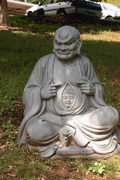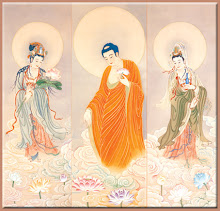 Elephant-Riding Arahant (Kalika)
Elephant-Riding Arahant (Kalika)
Kalika means elephant-rider. He was an elephant trainer turned monk. After his enlightenment, the elephant is a reminder of his previous profession and also symbolic of power, perseverance and endurance.
 Laughing Lion Arahant (Vajraputra)
Laughing Lion Arahant (Vajraputra)
Vajraputra literally means "man of cats." He was a lion hunter before he became a monk. After his enlightenment, a cub came playfully to his side and stay with him forever, as if expressing gratitude to him for giving up his killing therefore sparing its parents and brothers.
Open-Heart Arahant (Gobaka)

Gobaka (literally means ‘man of heart’) was a crown prince of an Indian Kingdom. When his younger brother wanted to start a rebellion, he assured his brother that he will refuse the kingdom and as a proof to convince his brother, he exposed his chest to show a Buddha in his heart. With that his younger brother was touched and abandoned the rebellion.
 Raised Hand Arahant (Pantha the Elder)
Raised Hand Arahant (Pantha the Elder)
According to legend, Pantha the Elder was the prince of a small Indian kingdom called Kintota. When he became a monk, he liked to meditate in the half-lotus style. Upon waking up, he would raise his hands and let out a deep breath, hence the name Raised Hand.
Thinking Arahant (Rahula)

Rahula (constellation that caused lunar eclipse) was one of the Buddha's 10 favourite disciples, and was well-known for his meditative power. It is believed that he could become omnipotent and omniscient during meditation. When deep in thought, he was ruminating wisdom and action.
 Scratched Ear Arahant (Nagasena)
Scratched Ear Arahant (Nagasena)
Nagasena was an eloquent speaker and debater. He was famous all over India for his preachings on the "hear no evil" maxim. The senses of hearing is one of the six sources through which mankind become aware of the world. Therefore a practitioner of Buddhism should avoid listening to decadent sounds and in particular other people's secrets. Thus he is often portrayed as scratching his ear, a gesture symbolizing the purification of the sense of hearing in the search for peace and quiet.

No comments:
Post a Comment